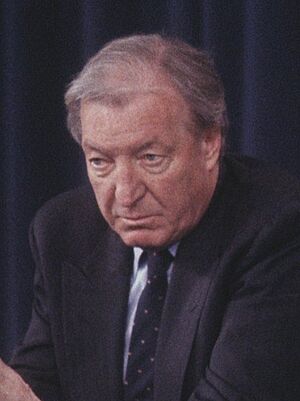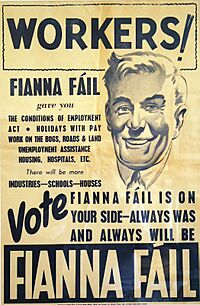Fianna Fáil facts for kids
Quick facts for kids <div style="padding-top:0.3em; padding-bottom:0.3em; border-top:2px solid Lua error in Module:European_and_national_party_data/config at line 227: attempt to index field 'data' (a nil value).; border-bottom:2px solid Lua error in Module:European_and_national_party_data/config at line 227: attempt to index field 'data' (a nil value).; line-height: 1;">
Fianna Fáil – The Republican Party
Fianna Fáil – An Páirtí Poblachtánach
|
|
|---|---|
 |
|
| Leader | Micheál Martin |
| Deputy leader | Jack Chambers |
| General Secretary | Seán Dorgan |
| Chairperson | Brendan Smith |
| Seanad leader | Fiona O'Loughlin |
| Founder | Éamon de Valera |
| Founded | 16 May 1926 |
| Split from | Sinn Féin |
| Headquarters | 65–66 Mount Street Lower, Dublin, Ireland |
| Youth wing | Ógra Fianna Fáil |
| LGBT wing | Fianna Fáil LGBTQI+ Network |
| Membership (2024) | |
| Ideology |
|
| Political position | Centre to centre-right |
| European affiliation | Alliance of Liberals and Democrats for Europe |
| International affiliation | Liberal International |
| European Parliament group | Renew Europe |
| Colours | <span style="background-color:Lua error in Module:European_and_national_party_data/config at line 227: attempt to index field 'data' (a nil value).; color:; border:1px solid #000000; text-align:center;"> Green |
| Anthem | "We'll Be There" |
| Dáil Éireann | Lua error in Module:European_and_national_party_data/config at line 227: attempt to index field 'data' (a nil value). |
| Seanad Éireann | Lua error in Module:European_and_national_party_data/config at line 227: attempt to index field 'data' (a nil value). |
| European Parliament | Lua error in Module:European_and_national_party_data/config at line 227: attempt to index field 'data' (a nil value). |
| Councillors |
246 / 949
|
| Website | |
| Lua error in Module:European_and_national_party_data/config at line 227: attempt to index field 'data' (a nil value). | |
|
^ a: previously a member of the Alliance for Europe of the Nations (2002–09) ^ b: Member of the EPD group from 1973 to 1984, the EDA group from 1984 to 1995, the UfE group from 1995 to 1999, the UEN group from 1999 to 2009, and the ALDE group from 2009 to 2014. |
|
Fianna Fáil (pronounced FEE-uh-nuh FOIL) is one of the main political parties in the Republic of Ireland. Its name means "Soldiers of Destiny" in the Irish language. The party's official full name is Fianna Fáil – The Republican Party.
Fianna Fáil was started in 1926 by Éamon de Valera. He and his supporters split from another party, Sinn Féin. The split happened because they wanted to take their seats in the Irish parliament, called the Oireachtas, which Sinn Féin refused to do at the time.
For most of the 20th century, Fianna Fáil was the most powerful party in Ireland. It has been in government more than any other party. Its main rival has always been Fine Gael. Both parties are considered to be in the political centre-right. This means they are generally more conservative than parties like the Labour Party or Sinn Féin.
From 1932 until 2011, Fianna Fáil was the largest party in the Dáil Éireann (the main house of the Irish parliament). After the 2008 economic crisis, the party lost a lot of support. In the 2011 election, it came in third place for the first time.
In 2020, Fianna Fáil did something new. It formed a coalition government with its long-time rival, Fine Gael, and the Green Party. The leaders of Fianna Fáil and Fine Gael agreed to take turns as Taoiseach (Prime Minister).
Contents
History of the Party
Fianna Fáil was founded by Éamon de Valera after he left Sinn Féin. He disagreed with Sinn Féin's policy of not taking seats in the Dáil. De Valera believed it was better to work within the government to achieve his goals for Ireland.
The new party quickly became popular. It appealed to farmers, working-class people, and the poor. Fianna Fáil promised to make Ireland's economy more independent. In 1932, just six years after it was formed, Fianna Fáil won the general election.
For the next 79 years, Fianna Fáil was a dominant force in Irish politics. It was in power for 61 of those years. All of the party's leaders have served as Taoiseach (the Irish Prime Minister).
The Dominant Years (1932–1973)
The party's strongest period was between 1932 and 1973. During this time, leaders like Éamon de Valera, Seán Lemass, and Jack Lynch led the country.
De Valera is remembered for keeping Ireland neutral and safe during World War II. His successor, Seán Lemass, focused on modernizing Ireland's economy. He helped prepare the country to join what is now the European Union.
Challenges and Changes (1970s–1990s)
In the 1970s and 1980s, the party faced new challenges. There were disagreements within the party on how to handle the economy and issues in Northern Ireland. This period saw Charles Haughey become leader.
Under Haughey, the party's time in government was less stable. Some members left to form a new party, the Progressive Democrats, in 1985. Haughey resigned as leader in 1992 after a controversy.
Later, Fianna Fáil formed coalition governments with the Progressive Democrats. In 1994, Bertie Ahern became the new leader. Under his leadership, Fianna Fáil was involved in the Good Friday Agreement in 1998, a major step in the Northern Ireland peace process. Ireland's economy also grew very strong during this time, a period known as the Celtic Tiger.
Recent History (2008–Present)
The party's success came to a halt after 2008. Bertie Ahern resigned as Taoiseach due to a controversy about money he had received. Soon after, a major economic downturn hit Ireland. The government, led by new Taoiseach Brian Cowen, was blamed for the problems.
In the 2011 general election, Fianna Fáil had its worst result ever. It lost most of its seats and became the third-largest party in the Dáil. Micheál Martin became the new leader.
The party slowly began to recover. After the 2016 election, it became the main opposition party. Following the 2020 election, Fianna Fáil entered a historic coalition government with Fine Gael and the Green Party. Micheál Martin served as Taoiseach for the first half of the term. After the 2024 election, Fianna Fáil became the largest party in the Dáil again and led the new government.
What Fianna Fáil Believes In
Fianna Fáil is often described as a centre to centre-right party. It is also known as a "catch-all party." This means it tries to appeal to a wide range of people from all social classes.
The party has a few core beliefs that have remained consistent:
- Irish unity: The party's main goal has always been to see a united Ireland.
- The Irish language: It supports the promotion and protection of the Irish language.
- Military neutrality: It believes Ireland should not join military alliances.
The party's name includes the words "The Republican Party." This refers to its goal of a united Ireland and its belief in the principles of liberty, equality and fraternity.
Over the years, the party's economic policies have changed. In the early days, it supported protecting Irish businesses from foreign competition. From the 1960s onwards, it shifted towards supporting free trade and encouraging international companies to invest in Ireland.
Fianna Fáil is generally supportive of the European Union. In the European Parliament, its members are part of the Renew Europe group, which is a liberal and centrist group.
Party Leaders
The leader of Fianna Fáil is one of the most important figures in Irish politics. All leaders of the party have also served as Taoiseach.
| Leader | Portrait | Period | Years as Taoiseach |
|---|---|---|---|
| Éamon de Valera |
|
1926–1959 | 1932–1948; 1951–1954; 1957–1959 |
| Seán Lemass |
|
1959–1966 | 1959–1966 |
| Jack Lynch |
|
1966–1979 | 1966–1973; 1977–1979 |
| Charles Haughey |
|
1979–1992 | 1979–1981; 1982; 1987–1992 |
| Albert Reynolds |
|
1992–1994 | 1992–1994 |
| Bertie Ahern |
|
1994–2008 | 1997–2008 |
| Brian Cowen |
|
2008–2011 | 2008–2011 |
| Micheál Martin |
|
2011–present | 2020–2022; 2025–present |
Fianna Fáil in Northern Ireland
For a long time, Fianna Fáil only operated in the Republic of Ireland. In 2007, the party announced it would start organizing in Northern Ireland. The goal was to eventually have candidates run for election there.
In 2019, Fianna Fáil formed a partnership with the Social Democratic and Labour Party (SDLP), a nationalist party in Northern Ireland. They agreed to work together on key issues affecting the whole island of Ireland. However, this partnership ended in 2022.
See also
 In Spanish: Fianna Fáil para niños
In Spanish: Fianna Fáil para niños














